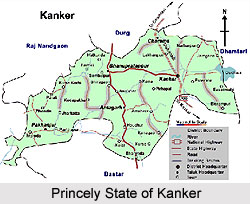 The Princely state of Kanker was one of the one prominent princely sates of India that was under the administration of the native rulers or Indian princes during the rule of British Empire in India. The state covered a total area of 1,431 sq m and consisted of a total population of 149,480 in the year 1941. Kanker state, also known as Kakeir, was bounded by the district of Drug in the north-west and by the district of Raipur in the northeast. Both the regions belonged to the British Central Provinces and Berar. It was bounded by Bastar in the south. The princely state included 505 villages in the year 1901. Kanker was a part of the Chhattisgarh States Agency under the Eastern States Agency.
The Princely state of Kanker was one of the one prominent princely sates of India that was under the administration of the native rulers or Indian princes during the rule of British Empire in India. The state covered a total area of 1,431 sq m and consisted of a total population of 149,480 in the year 1941. Kanker state, also known as Kakeir, was bounded by the district of Drug in the north-west and by the district of Raipur in the northeast. Both the regions belonged to the British Central Provinces and Berar. It was bounded by Bastar in the south. The princely state included 505 villages in the year 1901. Kanker was a part of the Chhattisgarh States Agency under the Eastern States Agency.
The Chandravanshi Rajputs of the Kshatriya caste were the ruling family of Kanker state. The 3rd ruler moved his capital to Kanker from Sihawa. The princely state of Kanker maintained its practical sovereignty even though it acknowledged the suzerainty of the Haihaivansi Rajput rulers of Chhattisgarh. It was forcibly made a vassal of the Marathas during the 18th century and was compelled to provide military service with 500 armed men. Raja Bhup Deo lost authority over the territory in the year 1809 for supporting the native ruler of Bastar against the Maratha forces. But it was restored later after his zamindari came under the control British East India Company in 1818. The state of Kanker was improved to the status of a feudatory state in the year 1865.
The native ruler of Kanker state held the title of Maharajadhiraj and took over the administration of the territory. The state was segregated into the 2 tahsils namely Kanker and Sambalpur. The princely state of Kanker, along with the states of Tripura, Seraikela and Kharsawan paid no tribute to the British Government of India. It was one of the original constituent members of the Chamber of Princes, a number of smaller states indirectly represented by 12 princes who were elected periodically by them. In the year 1940, the Raja was admitted to the Chamber in his own right.
The last ruler of the princely state of Kanker was Bhanu Pratap Dev, who acceded the state to the newly formed Union of India, after the country achieved independence from the dominion of the British. Bhanu Pratap Dev became elected MLA from Kanker constituency for two times.



















